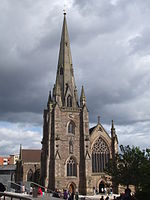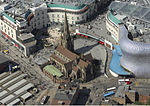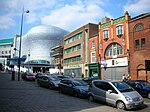Selfridges Building, Birmingham
Buildings and structures in Birmingham, West MidlandsDepartment store buildings in the United KingdomRecipients of Civic Trust AwardsSelfridgesUnited Kingdom building and structure stubs ... and 1 more
Use British English from August 2015

The Selfridges Building is a landmark building in Birmingham, England. The building is part of the Bullring Shopping Centre and houses Selfridges Department Store. The building was completed in 2003 at a cost of £60 million and designed by the architecture firm Future Systems. It has a steel framework with sprayed concrete facade. Since its construction, the building has become an iconic architectural landmark and seen as a major contribution to the regeneration of Birmingham. It is included as a desktop background as part of the Architecture theme in Windows 7.
Excerpt from the Wikipedia article Selfridges Building, Birmingham (License: CC BY-SA 3.0, Authors, Images).Selfridges Building, Birmingham
Park Street, Birmingham Digbeth
Geographical coordinates (GPS) Address External links Nearby Places Show on map
Geographical coordinates (GPS)
| Latitude | Longitude |
|---|---|
| N 52.477783333333 ° | E -1.8922583333333 ° |
Address
Selfridges
Park Street
B5 6BH Birmingham, Digbeth
England, United Kingdom
Open on Google Maps










